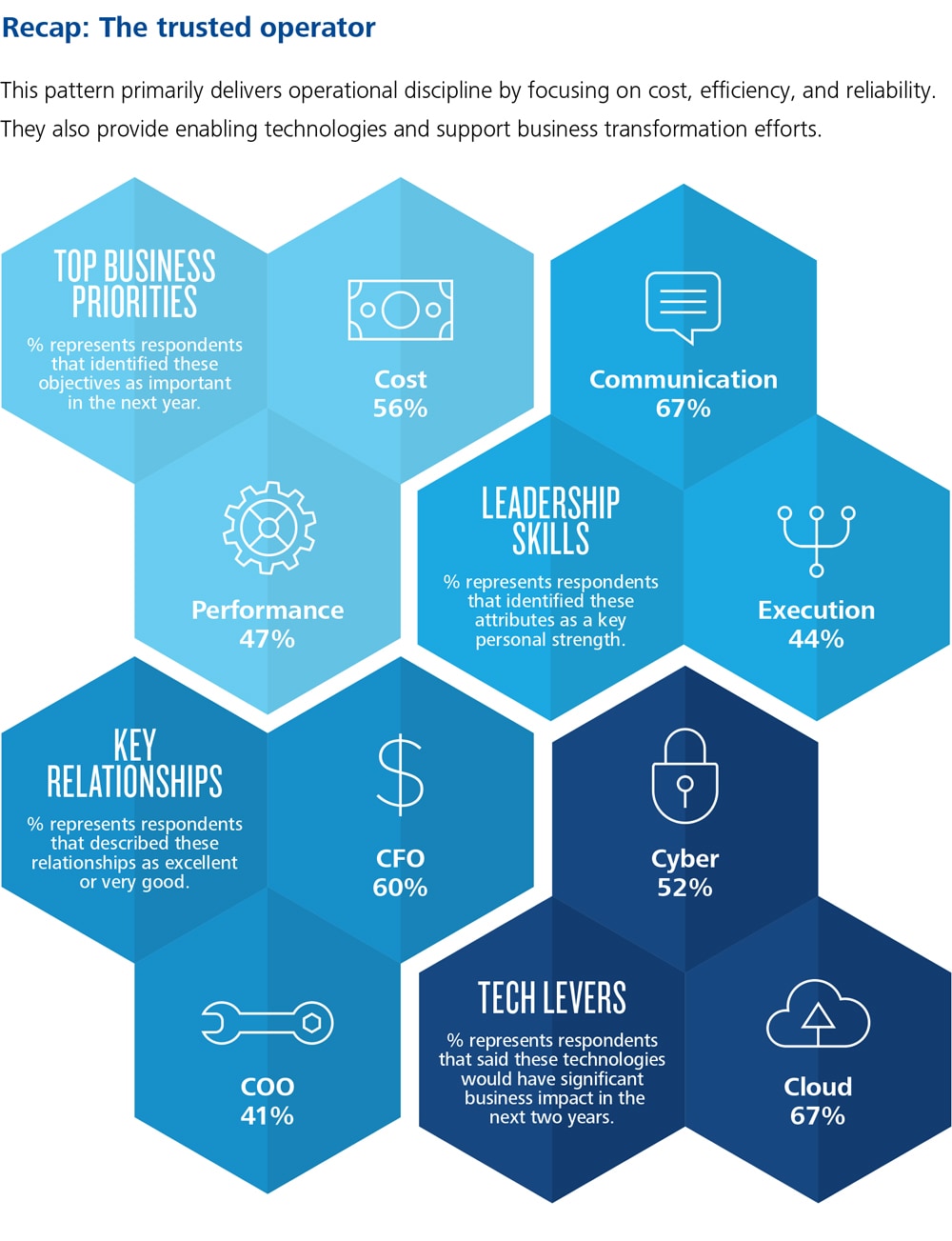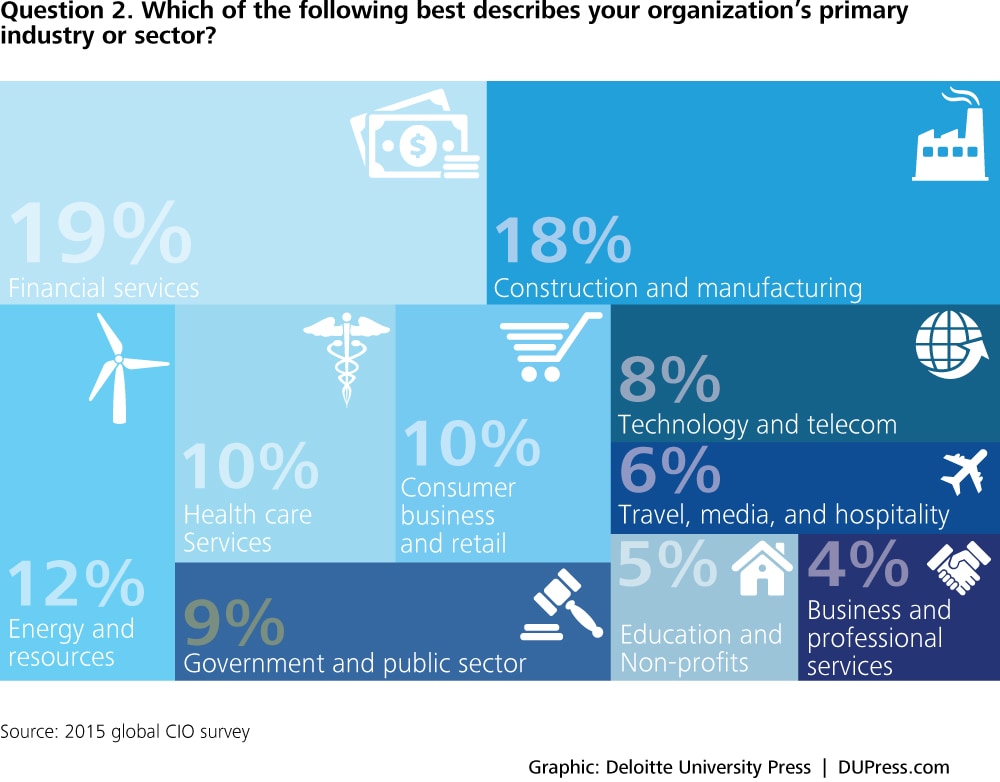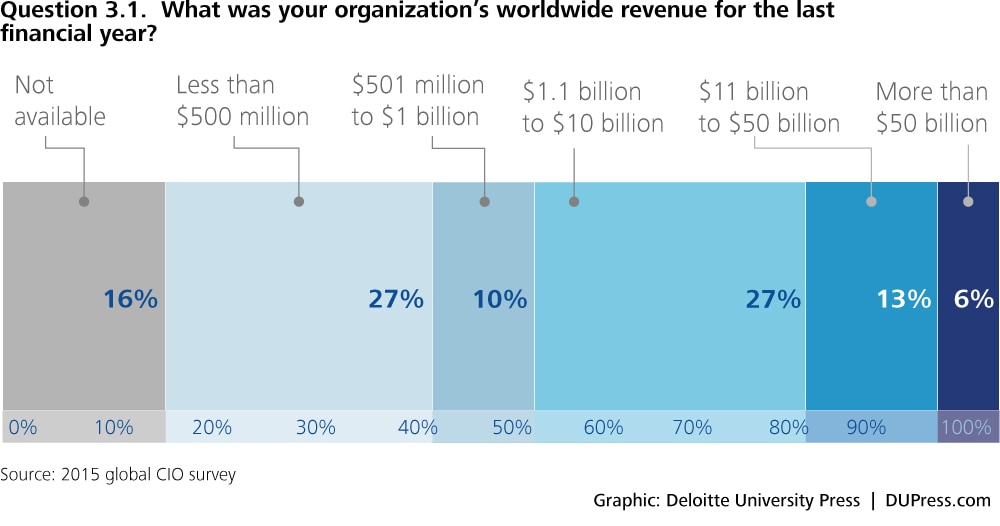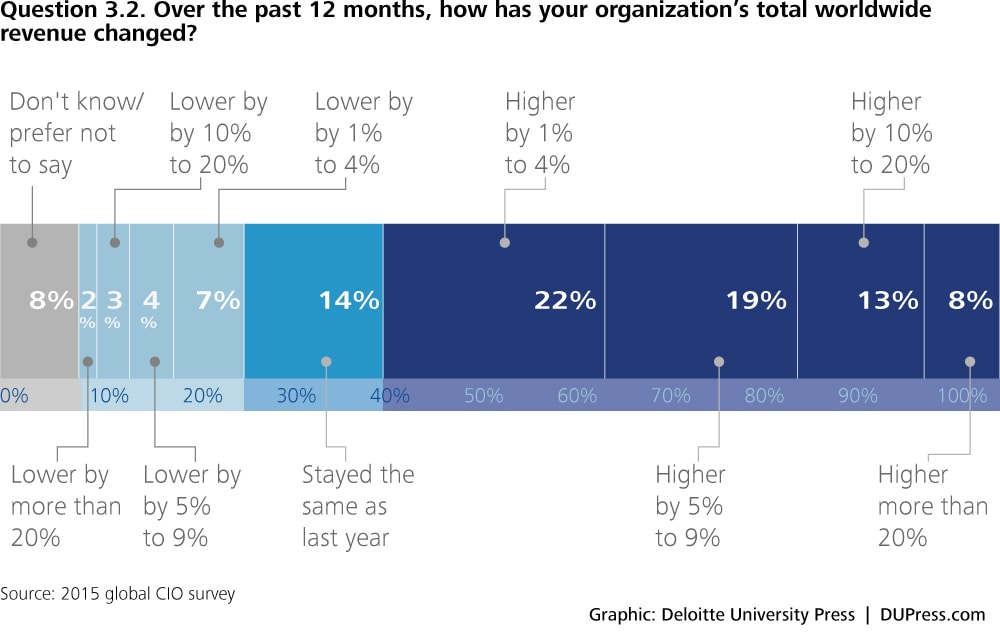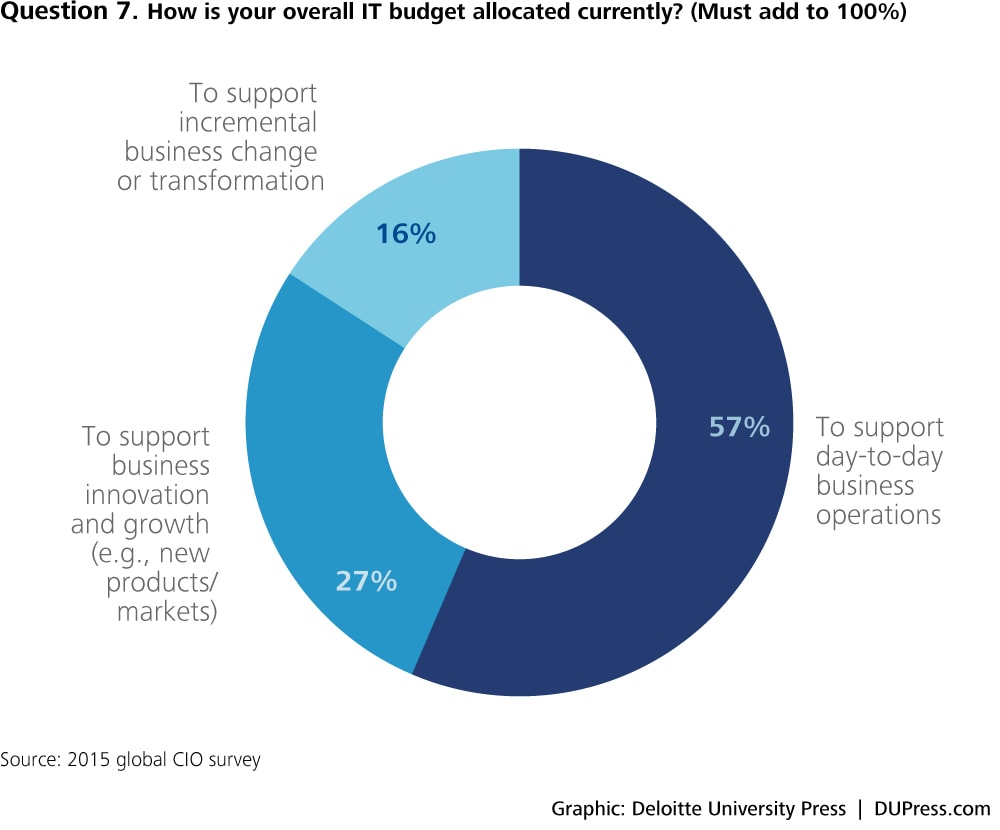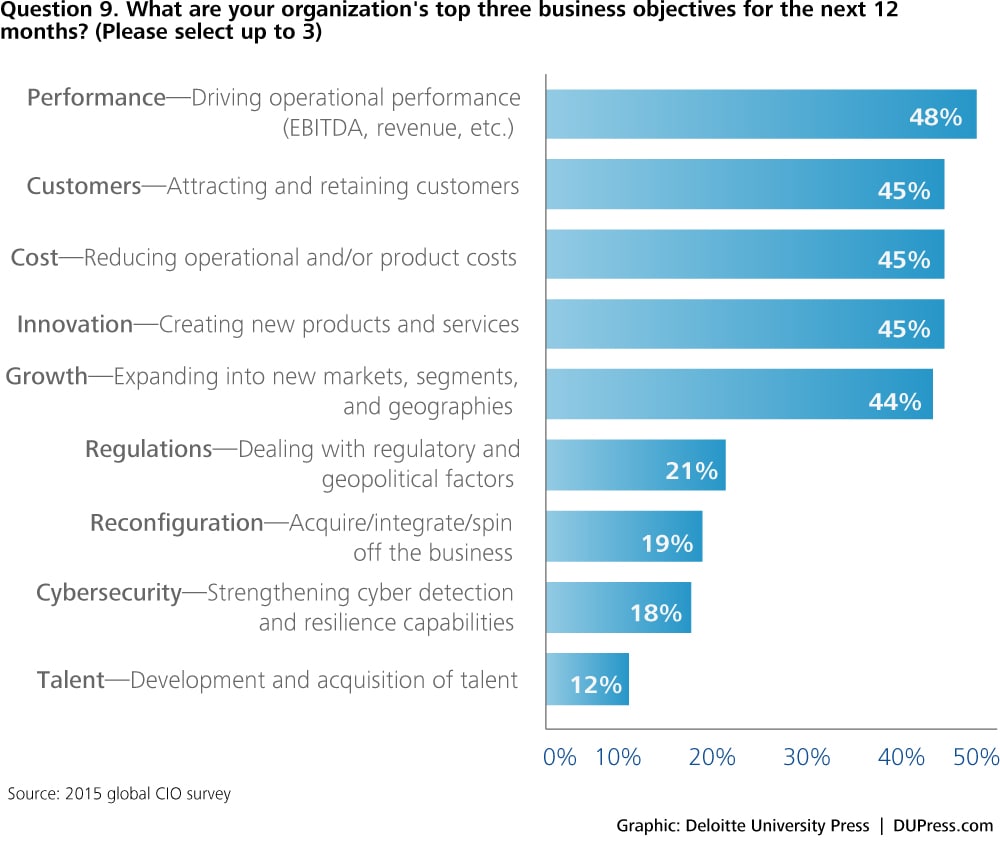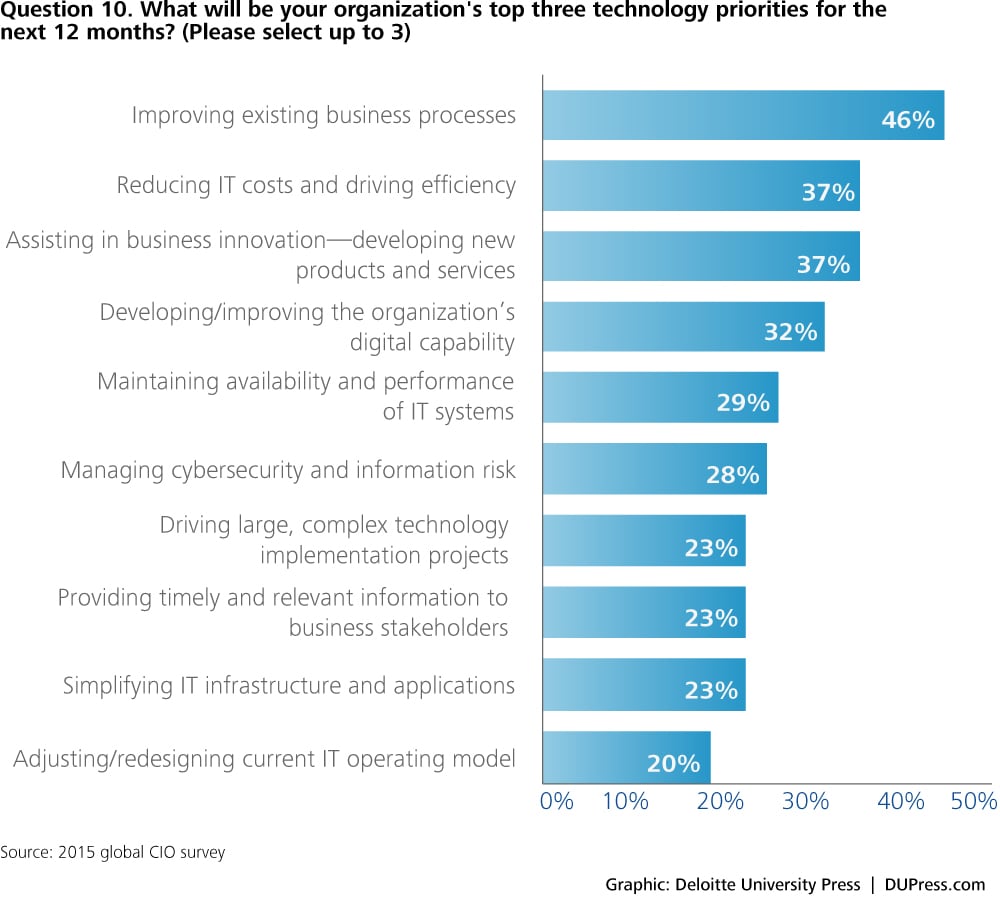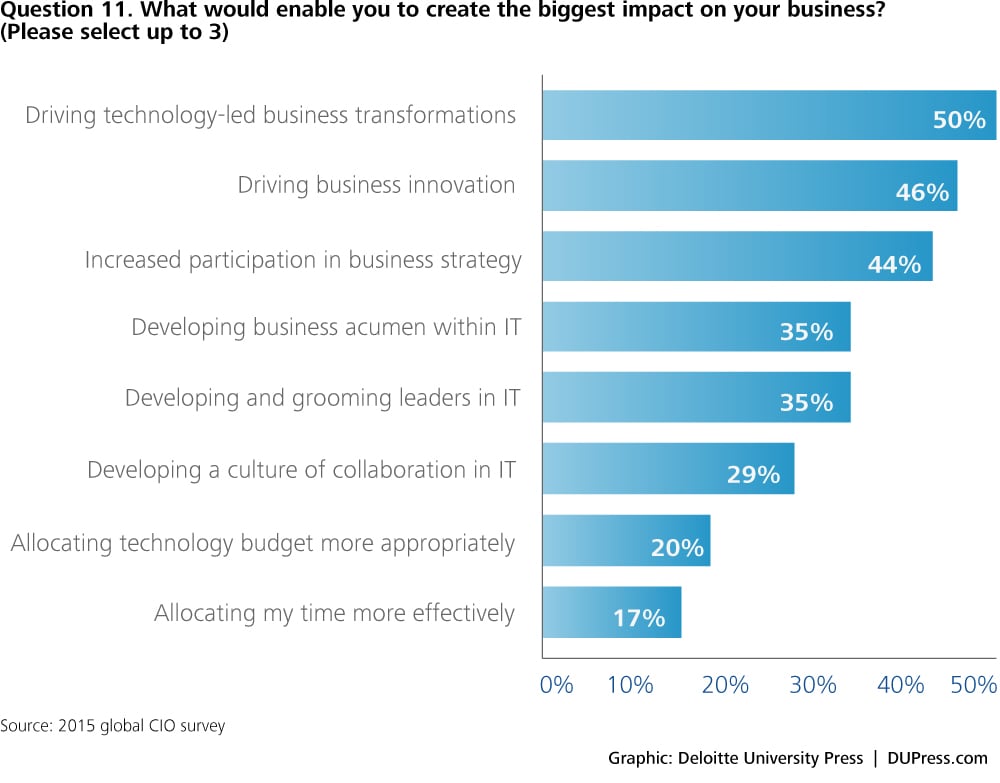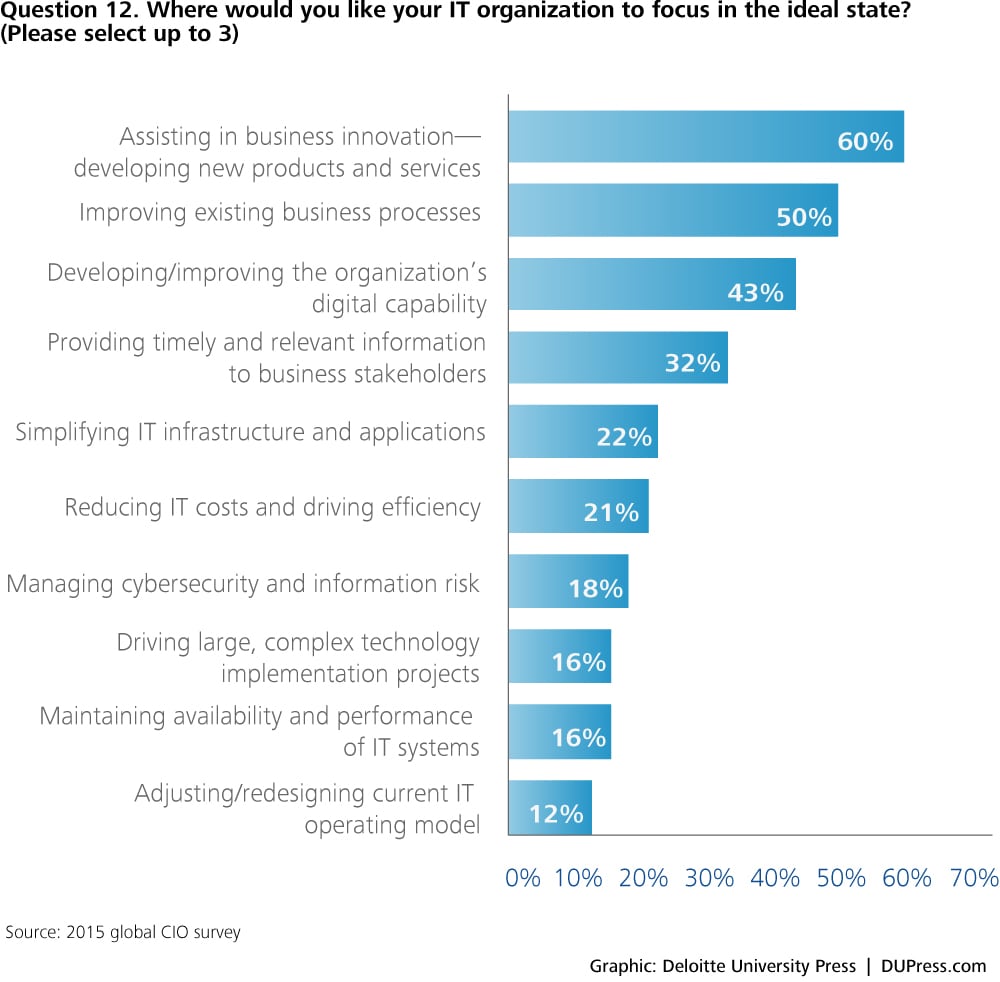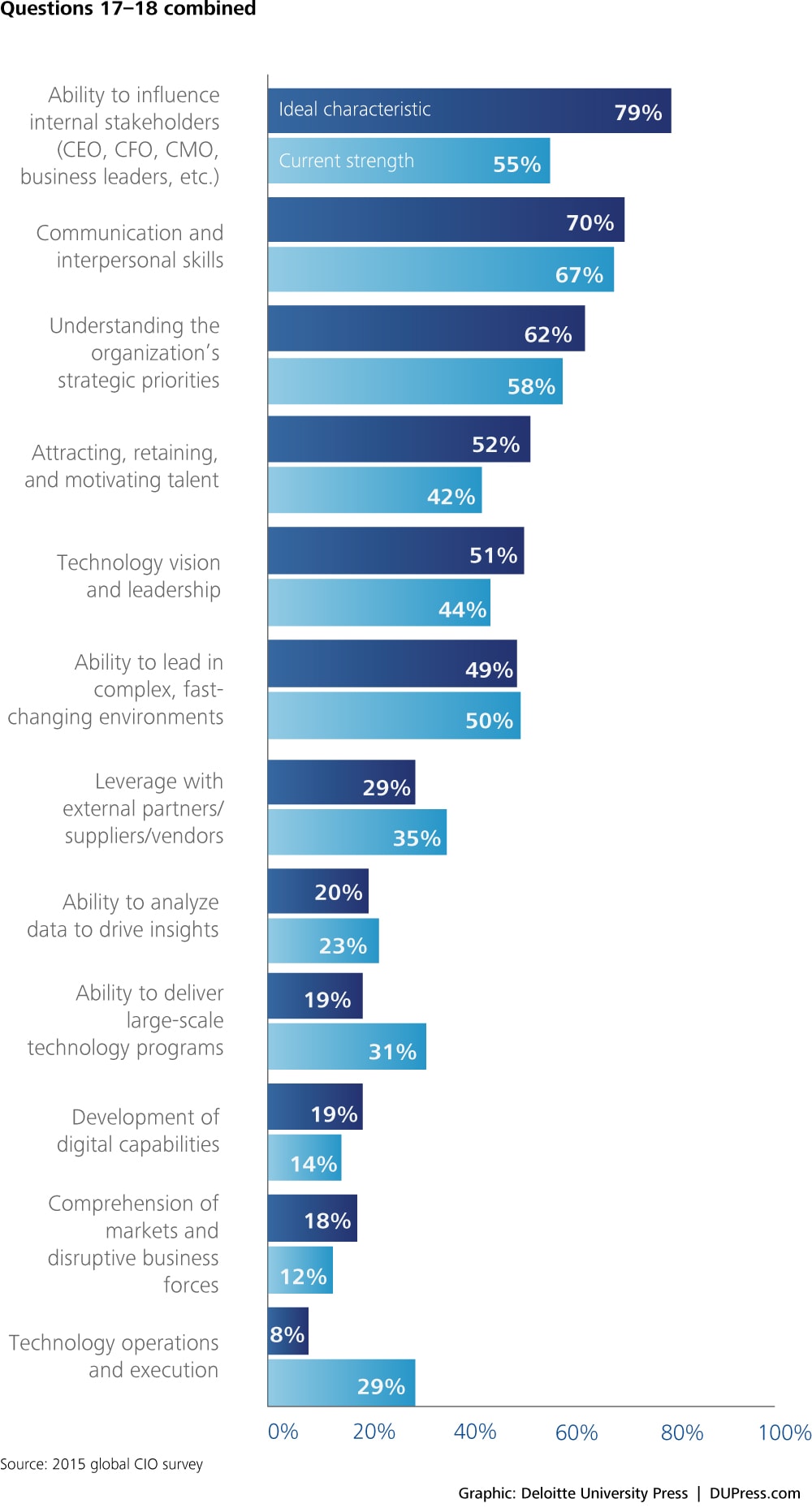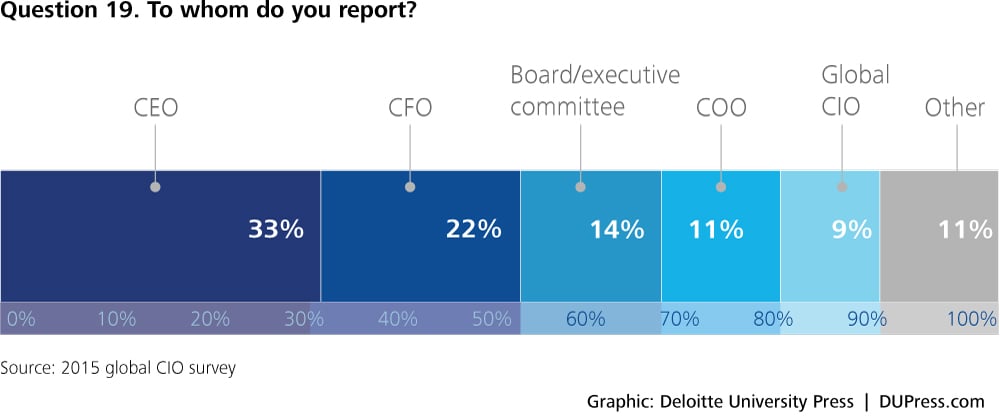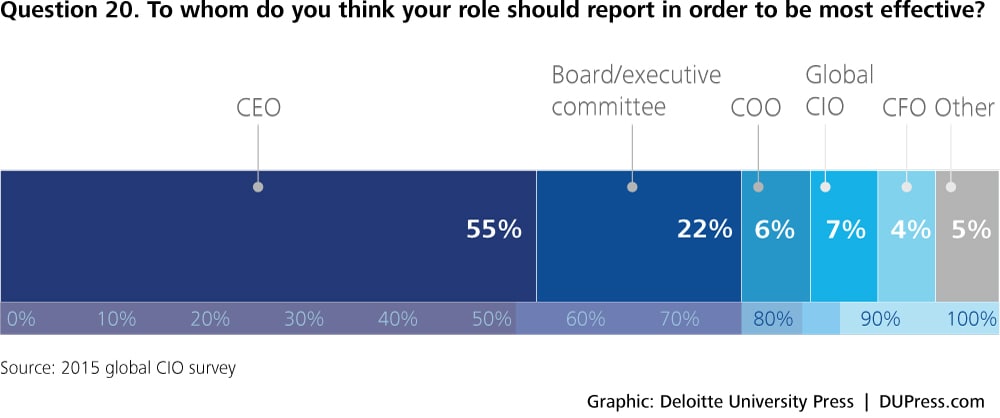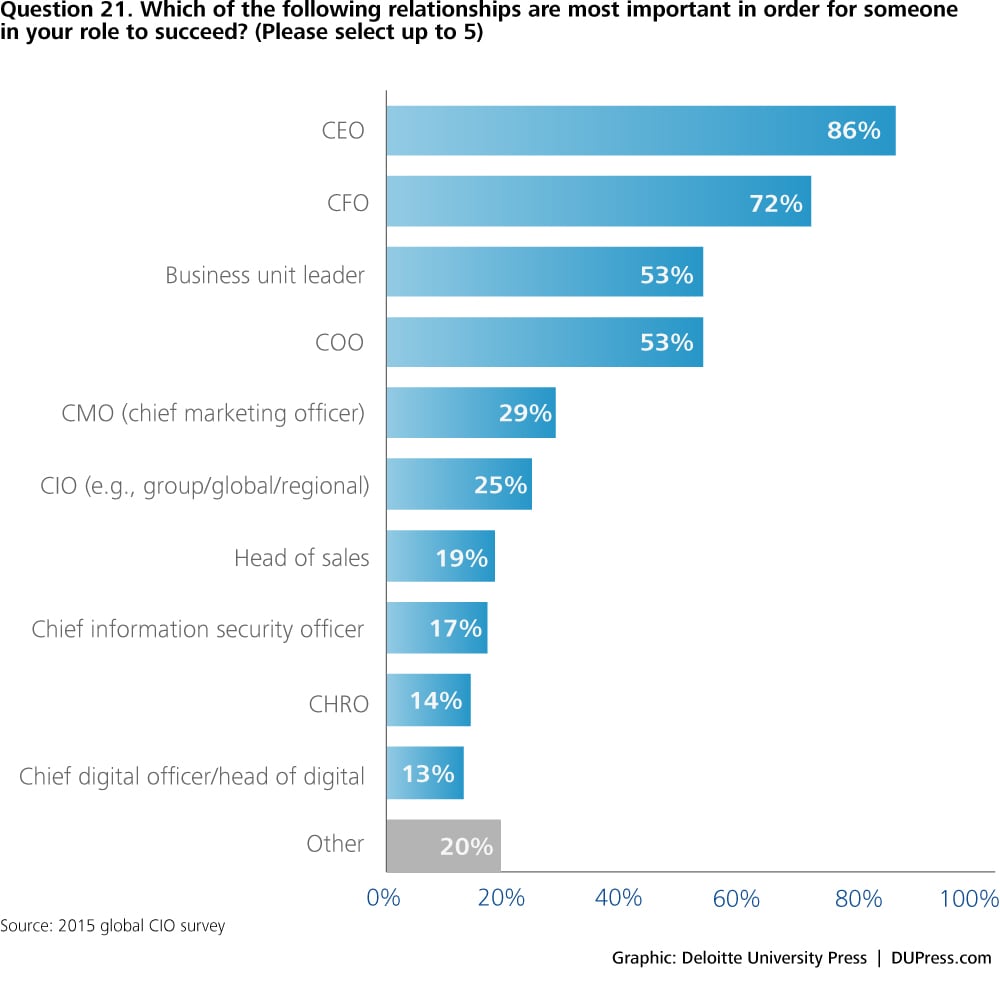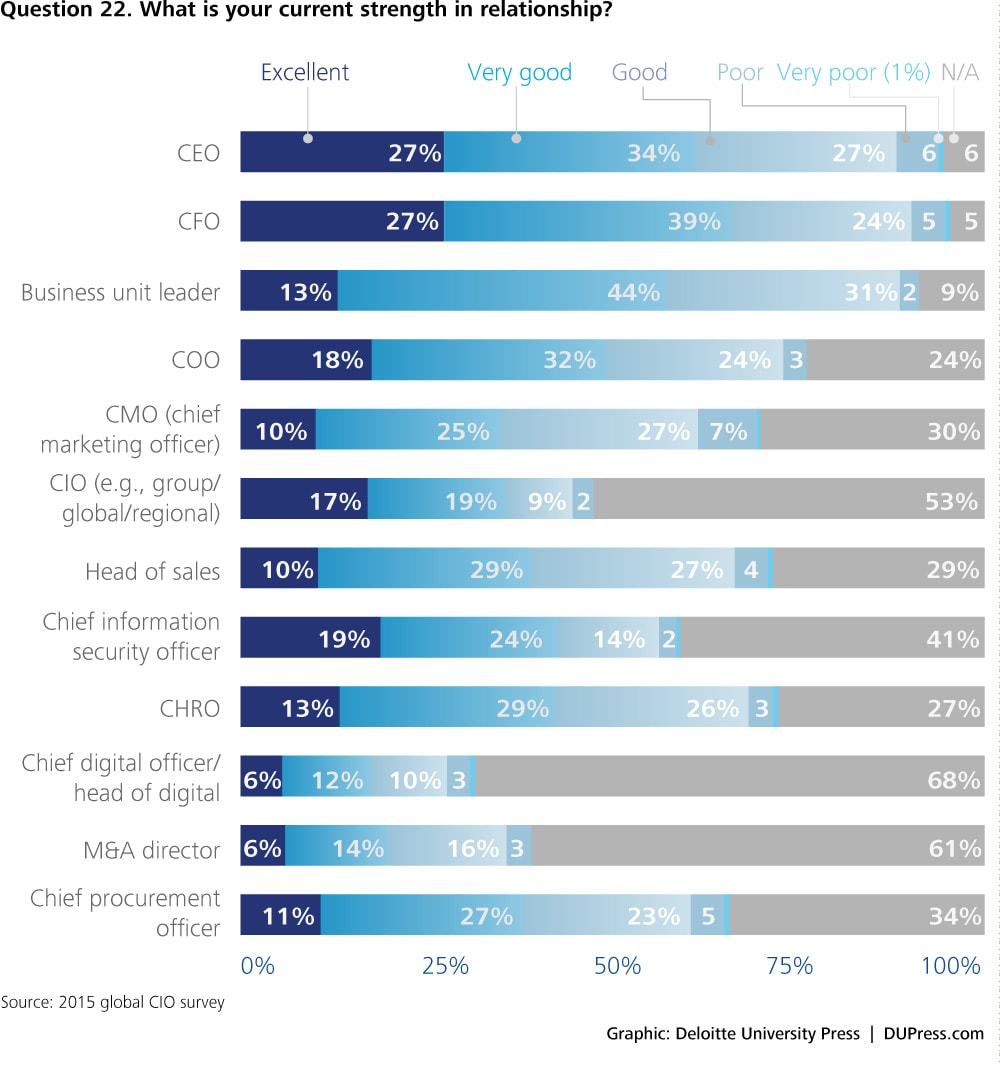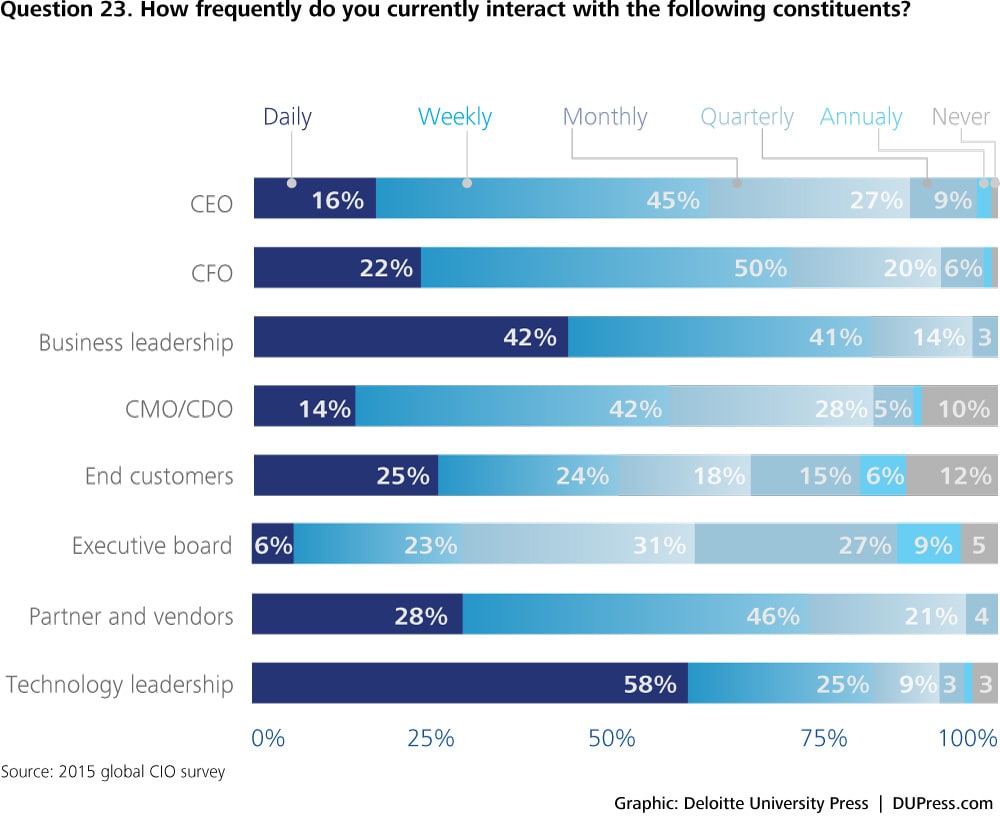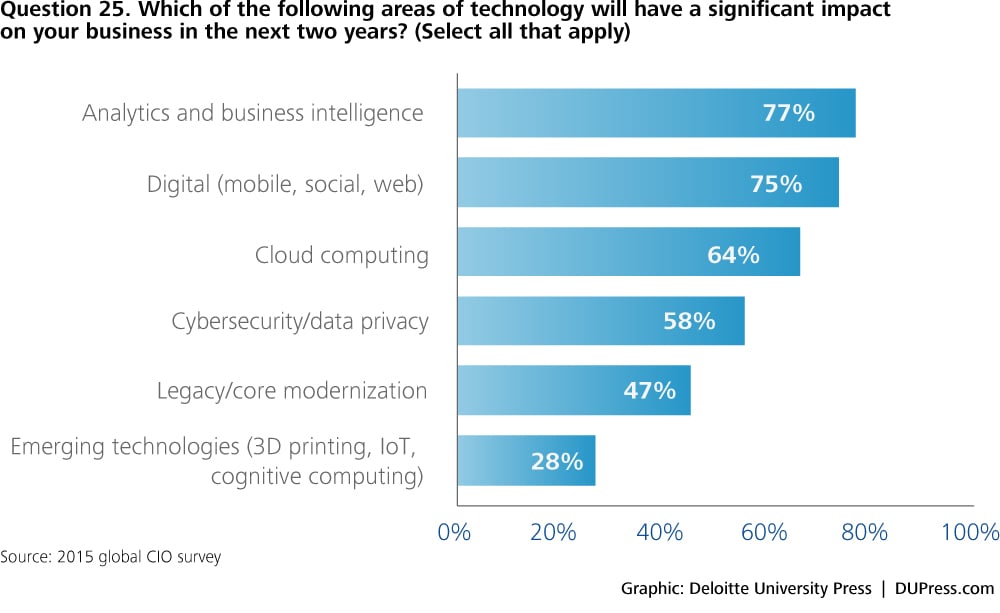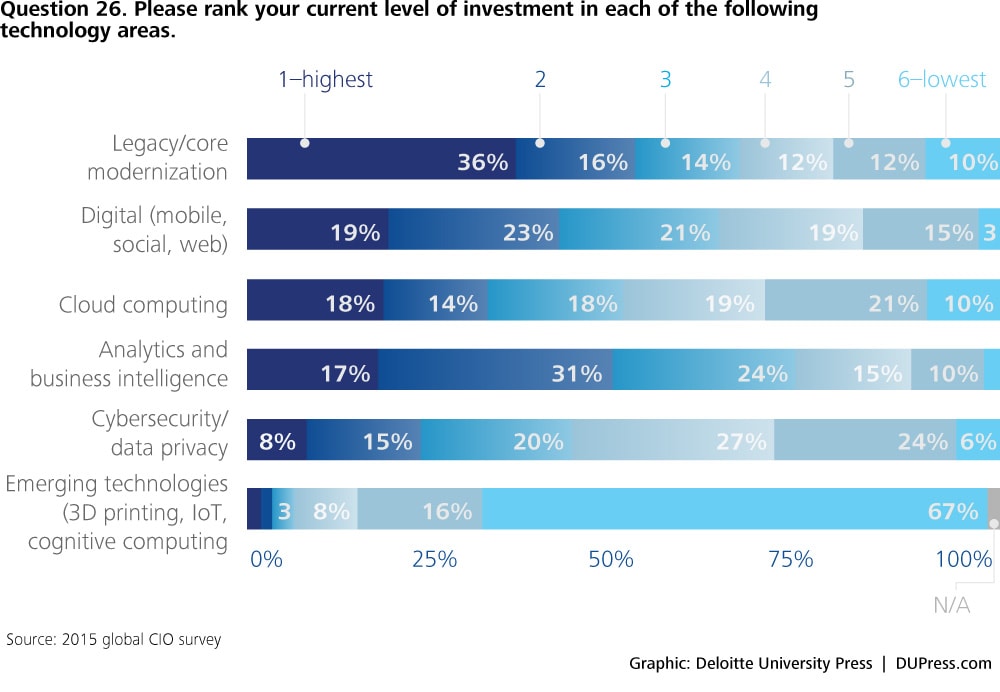2015 global CIO survey has been saved

2015 global CIO survey Creating legacy
04 November 2015
No matter what pattern you fall into as a CIO—trusted operator, change instigator, or business co-creator—it’s crucial to adapt your approach to changing business circumstances, adjusting the way you interact with peers and the business based on your time and place.
Preface: Creating legacy
We are pleased to share with you the findings from our 2015 global CIO survey, part of an expansive conversation with and among leading CIOs throughout the world. The survey was conducted by Deloitte’s CIO Program, representing our commitment to helping advance the careers, contributions, and impact of CIOs worldwide. Deloitte’s CIO Program brings together a multidisciplinary team of Deloitte leaders and experienced professionals with a commitment to help CIOs tackle what’s next in the face of growing challenges and demands. One way we deliver against that commitment is through research that seeks to understand distinctions in CIO roles and approaches to creating value.
Participate
Take the 2016-17 survey now
Read the report's
executive summary
View the related
related infographic
Explore the results in
interactive charts
In preparing for the 2015 global CIO survey, our team examined CIO job descriptions to determine the role of a CIO, which tends to vary much more widely than job descriptions for other CxO roles. We looked at the attributes, skills, and competencies that define the CIO role. Despite our initial hypothesis, we found no significant differences across industries, geographies, and company size in how CIOs delivered value. That said, that analysis did yield important insights about how CIOs operate within the leadership ecosystems of the organizations they serve. We learned that CIOs are laser-focused on understanding how they’re creating impact and value today—and where their value proposition is headed in the future.
Since the familiar dimensions of industry, geography, and company size shed little light on CIO roles, we turned instead to four elements we’ve used in more than 1000 executive Transition Labs conducted by Deloitte’s Leadership Center for Clients: business priorities, leadership and talent, relationships, and investment priorities. These four elements formed the framework for our 2015 global CIO survey, which engaged more than 1,200 CIOs and senior IT executives around the globe through surveys and interviews.
The 2015 global CIO survey marks the beginning of a multiyear research effort exploring the nature of the CIO role and legacy. It reveals three distinct clusters of how CIOs are delivering value today—and how they are preparing for what comes next. We hope these findings prove interesting and valuable as you think about your own legacy.
Best regards,
Khalid Kark
Research director
US CIO Program
Deloitte Services LP
Chapter 1. Framing the CIO legacy

For many, leaving a legacy is associated with the past or the end. But legacies are not defined at the end of the road but rather shaped by how leaders deal with the experiences, decisions, and challenges they face throughout the many phases of their career.
CIO legacy defines how technology leaders are delivering value to their organizations today—and how they are preparing themselves and developing the people, processes, and technologies for tomorrow.
This 2015 global CIO study, backed by experience with hundreds of IT leaders who have participated in our CIO Program, shows how the four framing elements listed below shape the context in which CIOs deliver value today—and tomorrow:
- Business priorities
- Leadership and talent
- Relationships
- Technology investment
Each element has a distinctive impact on CIO performance, and all four together frame a comprehensive picture of the forces at work around the CIO role and its legacy.
Business priorities: Context shapes the CIO agenda
Business priorities refer to the priorities forced on an organization by both the marketplace and the individual company strategy. It defines the boundaries of the CIO playing field and sets high-level expectations for performance.
Every company today is a technology company; CIOs are involved not just in driving efficiency, but also in reimagining customer experiences, reshaping how work gets done, and even rewiring business models. This is not just rhetoric. Our survey shows that across organizations big and small, across industries, and across geographies, CIOs have common business priorities, all directly linked to the heart of their businesses.
Global results: Five business priorities dominate the CIO agenda
CIOs around the globe were nearly unanimous in identifying the top five business priorities: performance, cost, customers, innovation, and growth (figure 1). These top priorities were consistent across industry, geography, and size of organization. One understandable exception: Only CIOs involved in the public sector selected “cybersecurity” over “growth” as a top business priority.
Figure 1. Business priorities (interactive chart)
Filter results by selecting industries, geography, or size below.
CIOs have moved from leading a supporting function to managing a business function—they reported that business leaders expect them to not only contribute to the bottom-line business priorities but also to enable and even drive top-line initiatives. Many CIO respondents described simultaneously juggling business performance and growth objectives with IT cost reduction and efficiency improvement.
The four priorities that did not make the top five list are also significant. Regulations and reconfiguration were important for some but not for all CIOs. In addition, cybersecurity and talent were lower enterprise priorities, perhaps because they are fundamental for achieving other priorities, or because they don’t drive profitability, or maybe because responsibility for these are shared with other executives. But both are critical building blocks that could impact all five top priorities, so it could be risky to ignore or deprioritize them.
Other significant findings
With the exception of the public sector, the top five priorities were consistent across industries, though there were some differences in emphasis (figure 2).
- Customers remain a focal point for travel and media. Almost three in four CIOs from travel, media, and hospitality selected “customer” as their top business priority.
- Cost dominates the CIO agendas in the government and energy sectors, with a majority of respondents in government (65 percent) and energy and resources (59 percent) picking “cost” as a top business priority.
- Performance and growth are top of mind for consumer business, manufacturing, and health care CIOs, with more than half of these CIOs selecting these as their business priorities.
- CIOs in technology and telecom, as well as in financial services, identified innovation as the top business mandate, with 58 percent and 50 percent identifying it as a business priority, respectively.
Key takeaway: Think ecosystem, not industry
CIOs today are operating in an environment where industry boundaries are blurring, supplanted by forces within their ecosystem of allies, partners, customers, and even competitors. Internal company goals and external competitive pressures are now dictating priorities, and CIOs must be able to operate “outside-in” with regard to their industry context.
Globally, CIO business priorities were not confined to their industry; in fact, more than half of the CIOs picked one business priority different from their industry’s top three business priorities.
“For a lot of companies, the CIO and CEO roles are going to start blurring; so much of what we do today is technology-driven, CEOs will start to acquire significant data skills or CIOs will be in a position to lead transformation and lead the company.” Anand Sahasram, CIO, McGraw-Hill Financial
That said, it’s essential to put first things first. One CIO had this advice for his peers: “If you don’t fulfill basic performance expectations, you’re a sitting duck.”
Another CIO, who had come from outside his company’s industry, found he had an advantage in challenging the status quo. He said, “Being new to an industry gives you the license to challenge the norms. I often found myself asking the question, Why are we doing it this way?”
Leadership and talent: Driving impact
Leadership and talent refer to the competencies and strengths the CIO brings to the table, both personally and via the larger team. This mix shapes the performance, value, and overall capabilities of the IT organization.
It is rare to find business leaders who take big risks, have the ability to craft a long-term vision, and possess the dedication needed to manage the day-to-day operations. But that is exactly the expectation for today’s CIOs. They have to be ambidextrous, contributing to business strategy on one hand while trying to ensure that day-to-day operations are running effectively on the other. Most importantly, CIOs need to have not only technology acumen but also the courage and conviction to lead their organizations through change.
Global results: Only 9 percent of CIOs say they have all the skills they need to succeed
In this part of the survey, we asked CIOs to select the top five competencies that a successful technology leader needs. Then we asked them to identify their own top five strengths. The gaps between these responses highlight areas where CIOs need to improve to make a lasting impact (figure 3).
Figure 3. Current CIO strengths versus ideal characteristics of a successful CIO (interactive chart)
Filter results by selecting industries, geography, or size below.
Out of the 12 leadership capabilities, CIOs overwhelmingly picked six as the most important for success in their role: influence with internal stakeholders, communication skills, understanding strategic business priorities, talent management, technology vision and leadership, and the ability to lead complex, fast-changing environments.
“If you are leading a large global organization, you need to be able to be approachable. If you’re not an effective communicator and speaker, and you are not able to connect to people on multiple levels, you can’t be a leader.” Mike Brown, VP Information Technology, ExxonMobil
Ninety-one percent of CIOs in our global survey acknowledged lacking at least one key skill. Three skills with the largest gaps were the ability to influence internal stakeholders, talent management, and technology vision and leadership.
On the other hand, three areas identified as significant current strengths were not considered differentiating skills for successful technology leaders. These areas were operations and execution, ability to run large-scale projects, and leverage with external partners.
These gaps point to a general proficiency in “managerial” skills and a relative deficiency in “leadership” skills for CIOs.
CIO reporting relationships
There was little consistency in reporting relationships among the more than 1,200 participating CIOs: 33 percent report to the CEO, 22 percent to the CFO, 11 percent to the COO, 9 percent to the global CIO, and 11 percent to assorted other roles. Fourteen percent of CIOs report to the board of directors, primarily in Asia-Pacific (24 percent) and South America (19 percent).
When asked which reporting relationship would most enhance their effectiveness, 47 percent of CIOs believed they would be more effective in a different reporting relationship. CIOs that reported to the CEO were very satisfied (89%), but only 18% of the CIOs that reported into the CFO thought that they were most effective in that reporting relationship. Most of them (55%) thought that they would be more effective reporting into the CEO. (figure 4).
Other significant findings
- Sixty percent of CIOs from larger organizations cited attracting, retaining, and motivating talent as a defining success characteristic—even though talent was not a top five enterprise priority. In contrast, only 43 percent of CIOs from small organizations (<1,000 employees) cited the talent agenda as a top priority.
- Only 33 percent of CIOs in travel, media, and hospitality selected the ability to lead in complex, fast-changing environments. The global average was 49 percent.
- Approximately 30 percent of CIOs in professional services selected development of digital capabilities, compared to only 10 percent of CIOs in energy and resources.
Key takeaway: Talent leadership creates more options for legacy
CIOs say the ability to attract, retain, and motivate talent are important requirements for a successful technology leader, but only 42 percent identified “talent” as one of their strengths. Few invest sufficient time in coaching, mentoring, and training their people.
“You build relationships by offering something of value—understanding priorities and helping others be successful. There is nothing better than shared success to build strong relationships.” Clark Golestani, EVP and CIO, Merck
CIOs unanimously expressed a desire to spend less time on operational activities and more on strategic activities. But when asked about their biggest obstacle, many responded that they lacked staff to whom they could delegate. Those CIOs who do invest in their talent often rely on their lieutenants to augment their own skill sets; they focus on building a team that can deliver a balanced set of IT capabilities.
One CIO advises his counterparts in this way: “CIOs tend to create organizational structure to support the areas where they don’t spend their personal time. I created organizational structure to support all my work, so I can spend my time where I want to or where it needs to be spent.”
Relationships: Building credibility and influence
Relationships define a leader’s credibility and impact. Establishing strong partnerships and deep engagement with C-suite leaders, employees, business peers, and external partners will allow a CIO to wield influence as a business leader.
The ability to influence internal stakeholders was among the top five competencies that successful CIOs require—and the largest personal competency gap. While many CIOs claim interpersonal skills as their strength—and say they have great relationships with business stakeholders—the survey results show that a majority of CIOs lack the influence to co-lead business initiatives such as business strategy and M&A activities.
Global results: Strong executive relationships do not necessarily mean strong influence
Not surprisingly, CIOs identified CEOs, CFOs, business unit leaders, and COOs as their most important relationships (figure 5). A majority of CIOs claim to have excellent or very good relationships with business stakeholders, but outside of this group, there is a long tail of relationships that need more attention. For example, only a third report strong relationships with sales and marketing executives. “A lot of CIOs listen to the business differently than they need to. They are trying to solve a problem as the discussion is happening instead of listening. It’s just like husband/wife communication: Sometimes you are hearing but are not listening,” said Mike Adams, CIO, Glazers.
Figure 5. Relationship strength and influence of CIOs (interactive)
Having good relationships, however, does not guarantee influence and credibility. One CIO advised that the four ingredients to build influence are “trust, credibility, consistency, and track record.” Our global data suggests that a majority of CIOs are not yet truly influential. Only 42 percent of the CIOs we surveyed were co-leaders in business strategy decisions and 19 percent in M&A activities.
Other significant findings
- Despite the recent hype, 20 percent of all CIOs in organizations with revenue above $50 billion cited a relationship with the chief digital officer as most important compared to the global average of 12 percent.
- CIOs in travel, media, and hospitality are most likely to interact with customers on a weekly basis (49 percent).
- CIOs from the United States interact with end customers less frequently than CIOs from other countries.
Key takeaway: Frequency of interaction matters
Relationships are not only about quality time; they’re also about quantity time (figure 6). Many CIOs said frequent interactions with other business stakeholders were a key ingredient to their effectiveness and influence within the C-suite. CIOs also pointed out that, if you aren’t adding value in these interactions, the amount of airtime you get with these executives may be severely curtailed.
“It involves a lot of time and a lot of little things—a series of actions to make sure you’re staying in touch, being deliberate about it, thinking about others in a different context, connecting to with them, picking up the phone, or adding extra time to a trip to go see them,” said the CIO of an energy and resources organization.
Another CIO, from a consumer business organization, said, “I have a regular conversation with the CEO—one-on-one—weekly or once every two weeks. It’s planned to be one hour long and typically goes to 1.5 hours. We talk about all of the issues from innovation to the state of the projects we’re doing to talent and leadership, board issues, issues facing the company, financials. We also talk about his [CEO’s] team, the players, the interactions, and what needs to happen. He uses me as a sounding board.”
Technology priorities and investment: Driving value
Technology investments are the currency CIOs use to create value. The budgets that CIOs oversee and influence are a direct reflection of what they consider important and how they are creating value for the organization. Regardless of industry, geography, and organization size, CIOs reported similar percentages in spending across support for day-to-day operations, incremental business change, and business innovation and growth (figure 7). It’s the age-old challenge of optimizing operational spend while creating a long-term vision and infrastructure to support the future needs of the business. CIOs reported the highest current investments in legacy and core modernization.
Global results: It’s all about business value
When asked which technologies will have significant impact on the business within two years, CIOs unsurprisingly named analytics, business intelligence, and digital (figure 8). What was surprising was that the definition, scope, and specific technology investments for each of these technology initiatives varied significantly from organization to organization.
Figure 8. Current technology investments and future business impact (interactive)
“Legacy and core modernization is critical given the combination of (1) very robust, large-scale systems that have been doing things one way for a long time, and (2) a rapid level of change that demands things be done differently quickly. Agility of scale and modernization is critical.” Steve Betts, enterprise CIO, Health Care Service Corporation
For example, digital investments could mean anything from analyzing customer data and developing new products and services to improving customer experience and enabling the workforce to better collaborate or be more productive. For Randy Kupper, CIO, Ameriprise Financial, Inc., “The biggest emphasis for digital capabilities is driving efficiencies to our advisors to help them be more productive. It’s a key component of how we’re evolving our support and adding value to their practices and Ameriprise.”
This lack of definition is often confusing for business leaders and can lead to misunderstandings and conflicting goals. These technologies are interdependent, and very often, a combination of platforms come together to deliver business value. As CIOs communicate about these technologies, they need to talk less about technology itself and more about the business solutions, impact, and value that the technology delivers.
Two-thirds of technology budgets are spent on maintaining day-to-day business operations, and often there is pressure on the CIO to invest more in business innovation. It is important to recognize that spending on innovation also has a long tail of operational spend in subsequent years. Globally, 16 percent of the respondents’ current budgets is allocated to business innovation and growth (see figure 7).
Other significant findings
Based on their industry, CIOs expect different technologies to have a significant impact on their business within the next two years.
- Analytics: Seventy-seven percent of the CIOs selected analytics; industries with large customer bases and complex value chains such as manufacturing and construction were more likely to pick analytics as a disruptor.
- Digital: Seventy-five percent of the CIOs picked digital, especially from industries that provide products to end consumers such as financial services, education, and consumer business and retail.
- Cloud: Sixty-four percent of the CIOs picked cloud. Adoption is upending technology in many sectors, especially consumer business and retail; technology and telecom; and travel, media, and hospitality.
- Cybersecurity: Fifty-eight percent of the CIOs picked cybersecurity. It matters especially where risks and trust collide, such as in financial services, energy, and government.
- Legacy and core modernization: Even though legacy and core modernization was the highest in current spend, only 28 percent of the CIOs said it will have a significant impact on their business in the next two years. As investments in digital, analytics, and cloud increasingly depend on core systems, there is an opportunity to shift core modernization from rote upkeep to establishing the foundation for more disruptive technologies.
Current investments in cybersecurity were relatively low except for public sector respondents globally and respondents from the United States. This was surprising given that underinvesting in cybersecurity could derail investments in other technology areas.
Technology investments represent the basis of value and impact for a CIO. Business leaders expect CIOs to provide the competitive or performance edge to their organizations through technology. Getting it right is table stakes—a prerequisite for having a seat at any other table.
Key takeaway: Build a strong foundation to benefit from digital and analytics
Globally, three out of four CIOs picked analytics and digital as two technologies that will impact their business in the next two years. But many CIOs said that to take full advantage of these technologies, they would need to revamp their existing legacy and core infrastructure. Many are finding it hard to get the funding to do that.
One CIO said that maintaining the reliability and performance of core operations was essential for them because these core systems yield enormous amounts of transactional data that can fuel innovation.
Chapter 2. Sculpting your CIO legacy

The 2015 global CIO survey demonstrates that CIO effectiveness is shaped significantly by an organization’s business priorities—and that leadership capabilities, relationships, and investments are the key levers that CIOs use to drive performance. As we explored the survey data more deeply, however, we uncovered three different patterns that describe how CIOs are delivering value today—and how they are preparing for what comes next. These patterns (figure 9) provide a powerful approach for understanding how CIOs must adapt to meet the dynamic requirements of their roles—and build a lasting legacy.
Figure 9. Three distinct patterns of how CIOs deliver value (interactive chart)
Click and drag the chart to rotate and view from various angles.
- Trusted operators deliver operational discipline within their organizations by focusing on cost, operational efficiency, and performance reliability. They also provide enabling technologies, support business transformation efforts, and align to business strategy.
- Change instigators take the lead on technology-enabled business transformation and change initiatives. They allocate significant time to supporting business strategy and delivering emerging technologies.
- Business co-creators spend most of their time on driving business strategy and enabling change within their businesses to see that there is effective execution of the strategy.
As you think about the three patterns and chart out a plan for how you need to evolve, consider the following:
- One CIO legacy pattern is not better than the others. What matters is choosing the pattern that matches the business context as framed by the four elements at any given time.
- CIO legacies are works in process; patterns are fluid. A different pattern may be needed when the business context changes. For example, when you transition to a new organization or when a new business strategy emerges, you may find yourself needing to adopt a new pattern. Similarly, your pattern evolves as a result of the challenges and experiences you have as a leader.
- Leading CIOs consciously move from one pattern to the other based on their time and place. They develop, hire, or rent talent to fill any gaps in complementary skills needed to succeed and add business value.
Trusted operators: Adding value through operational performance
Trusted operators are the largest CIO legacy group at 42 percent; their primary mission is to see that the systems are running effectively and efficiently. They have good business stakeholder relationships; their key strength is operations and execution expertise. Trusted operators are more likely than others to name regulatory compliance as a business priority, and they see cybersecurity and information risk as strategic investments. They are much more bullish than others on the likely impact that cloud technologies will have on their business over the next two years. A CIO of a large professional services firm said, “There are a number of CIOs who would say that the CIO role needs to be more on the strategic side. I think the job of the CIO is to run a very large IT organization, and you can’t ignore it.”
Business priorities: It’s all about efficiency
The business expects trusted operators to concentrate their efforts on the fundamentals of delivering consistent, reliable, scalable, and secure technology—all while ensuring cost efficiency. There is also an inherent expectation that these CIOs will be able to “steady the ship” by defining a strong governance structure and aligning IT operations with overall business objectives.
Trusted operators’ top business priorities are cost and performance (figure 10). More than half identified cost as a top-three business priority. An executive vice president and CIO of a US health care company said, “One strategic aspect of what we’re doing is becoming more affordable. We’ve committed that we aren’t going to increase health care costs, which is putting cost pressure on the organization as a whole. So from a technology perspective, I have two responsibilities: using technology to reduce costs and looking within my own organization to reduce costs.”
Figure 10. Business priorities among the three patterns (interactive chart)
Filter results by selecting pattern or industry below.
Also, trusted operators identified attracting and retaining customers as their third-highest business priority, with a focus on delivering reliable back-end infrastructure. For this profile, the customer is almost always the internal party, since they rarely engage directly with external customers.
With their energies squarely focused on cost and performance, trusted operators are much less likely than CIOs of the other two patterns to be in organizations that have innovation and growth as their top priorities. Even in situations where they are asked to support such initiatives, trusted operators are likely to focus on providing enabling technologies and processes instead of leading these innovation and growth initiatives.
Trusted operators tend to be strong partners and enablers but will rarely lead business innovation and growth initiatives.
Leadership and talent: Engaging stakeholders, driving execution
Trusted operators have a knack for developing clear governance and effective cost-control mechanisms. They are able to gain the trust of their stakeholders by enabling and aligning technology with business objectives. A majority rated influencing internal stakeholders as a top strength, as the CIO of a European government agency said, “I want to create a foundation to deliver flexible technologies that support the evolving needs of my business peers.
Their core competency is to drive down costs by rationalizing, renewing, and consolidating technology. Not surprisingly, 44 percent picked technology operations and execution as one of their top strengths (figure 11). Trusted operators are twice as likely as other CIOs to identify this as a top strength. “You need to have a sense of how things are operating. If you can’t speak to that with a lot of knowledge, you begin to lose your influencing capabilities. You have to be ‘in the know’ to have the conversations that matter,” said the CIO of a large financial services company.
Figure 11. Current CIO strengths versus ideal characteristics of a successful CIO: Trusted operator versus all respondents (interactive chart)
Filter results by selecting industry or pattern below.
Relationships: CFOs, CEOs, and the workforce
Because of their cost mandate, trusted operators are most likely to report to the CFO. More than 60 percent report having an excellent or very good relationship with their CFO. They also have strong relationships with CEOs because of their focus on bottom-line impact. A CIO of a telecommunications company said, “For me, it’s the CFO—he’s my boss, he gives me air cover, we have a great partnership, and I respect him.”
Trusted operators are least likely to have excellent relationships with heads of marketing and sales; only a third reported excellent or very good relationships (figure 12). This is logical, since trusted operators are passionate about managing the operations and execution of technology but don’t typically get involved in customer-facing functions.
Figure 12. Trusted operator: Relationship strength and influence of CIOs (interactive)
Filter results for trusted operator by selecting from pattern tab below.
In our interviews, many trusted operators shared that their mission to actively engage with their workforce helps them be more productive, collaborative, and motivated. For example, a CIO of a global consumer products company said, “We have thousands of employees in the United States, and technology can make their lives better. I have lofty aspirations to use technology to give them access to things they couldn’t get unless they worked here.”
Technology investments: Improving enabling technologies
Trusted operators rank digital as the technology that will most impact their business in the next two years, closely followed by analytics and cloud (figure 13). Although their choices are similar to those of other patterns, our interviews revealed that their investment priorities are focused on enhancing technology and enabling versus transforming business operations. They invest their energies in:
Figure 13. Trusted operator: Technology investments (interactive)
Filter results for trusted operator by selecting from pattern tab below.
- Digital and analytics investments to support workforce enablement, internal collaboration, mobile solutions, and other investments that improve efficiency and productivity.
- Cloud investments to deliver efficiency, agility, and simplicity and as a tool to migrate to simpler, more efficient architectures. For cloud, cost is a big decision driver.
- Cybersecurity to deliver reliable and effective technology services (figure 14). Since regulatory compliance is often a business priority, trusted operators are frequently able to get the funding to enhance systems security while ensuring compliance. The CIO and senior vice president of a telecommunications company said, “Over the past three years, cybersecurity has become top of mind for everyone—board, audit committee, executives. We put together a framework for approaching cyber as a program instead of willy-nilly. Security has matured significantly.”
Change instigators: Driving business innovation and customer value
Change instigators represent the smallest CIO legacy pattern group, accounting for 22 percent of our survey population. A change instigator’s primary motive is to lead transformation efforts and be the change agent within the organization. “IT winds up being a tip of the spear as change agents; everyone rides behind it,” said the CIO of a large health care company.
Change instigators spend much of their time, naturally, initiating change, and ensuring operational infrastructure is in place to support this change. They have strong involvement in supporting end customers and are most likely to be engaged in end-customer-related initiatives. Change instigators are also more likely to be found in organizations undergoing fluctuating corporate revenues.
Business priorities: Innovation and customers
“Some would say we have an engineering mindset, that we engineer products for engineers. We’ve had situations where we took a jewel and over-engineered it. We’ve learned the lesson that the customer should be in the middle, with products and services surrounding them,” said the VP and CIO of a global industrial manufacturing company.
Change instigators are actively looking for ways to enhance the role of technology in their organizations. They are often brought in to change the status quo, and they naturally look outside the enterprise to get ideas. Compared to trusted operators and business co-creators, change instigators are more likely to select growth and innovation as their top business priorities.
Since their mandate is to drive change, cost reduction is not high on the change instigator’s agenda. They are less likely than others to have cost as a business driver (38 percent versus 45 percent) (figure 15).
Figure 15. Business priorities: change instigator (interactive chart)
Filter results by selecting pattern or industry below.
Leadership and talent: Adapting to fast-changing environments
Like their peers, communications and understanding business priorities are change instigators’ top two strengths (figure 16). True to their pattern, they also identified leading in complex, fast-changing environments (54 percent) among their top strengths, followed by technology vision (51 percent) and influence with stakeholders (50 percent). For example, the global CIO of an energy and resources company said, “If I were to take you through my career path, it wouldn’t make sense. I’m running operations for a few years, leading a large global effort overseas, back to running operations, and then taking on another complex internal project. I finally figured it out: What I do is I manage large, complex problems. That is the unique skill I’ve acquired over the years. Now I’m applying it to IT.”
Figure 16. Current CIO strengths versus ideal characteristics of a successful CIO: Change instigator versus all respondents (interactive chart)
Filter results by selecting industry or pattern below.
Change instigators have an unambiguous view of their destination. They are experts at painting a picture of this destination and motivating others to follow and execute. Change instigators are 21 percent more likely than other CIOs to call technology vision a strength.
Relationships: Customers and business partners
Because of their mandate, change instigators typically report into the CEO. While only 50 percent see building internal relationships as a top strength, change instigators often reach outside their organizations to build partnerships and alliances that allow them to harness information and build capabilities. They are heavily involved in utilizing technology to enhance customer experience. “It is a skillset the CIO needs to develop: Listen more, and listen with a business ear versus a technology ear,” said the CIO of a consumer business and retail company.
Equally important, change instigators are focused on leveraging data from external and internal sources to help their organizations make more educated decisions. More than their peers, they are likely to be engaged in building technology platforms (70 percent), as well as gathering and analyzing data on end customers (38 percent) (figure 17).
Technology investments: Focused on customer experience and agility
Change instigators are highly interested in aggregating and analyzing data to help business leaders make more informed decisions. They ranked analytics as the technology that will most impact their business in the next two years, followed by digital and cloud (figure 18). A CIO of a high-tech company described his challenges of switching his applications into the cloud: “There’s a naïveté at the executive level about cloud. People don’t understand how difficult it is to integrate it with the rest of your business. They think you just flip a switch. Let’s be clear—very few cloud applications in a Fortune 500 company stand alone. The integration makes it a very difficult proposition.”
Figure 18. Change instigator: Technology investments (interactive)
Filter results for change instigator by selecting from pattern tab below.
Change instigators’ investment priorities tend to be customer-focused, with a priority on flexibility and speed.

Business co-creator: Driving and enabling strategy
Business co-creators account for little over a third (35 percent) of the survey population. Their primary job is to support and drive business strategy. They also balance their time to provide enabling technologies and lead change initiatives. They take care that their teams are delivering supporting technologies and ensuring reliable execution. Co-creators represent the most balanced of the three patterns in terms of time allocation across the breadth of CIO activities. “We are in the middle of a big merchandising transformation program, taking all of the business processes and standardizing on a single platform. Our strategy is to enable the delivery of products and services in an omnichannel world: One system, one inventory, one product, and one vision that supports the growth strategy,” said the senior vice president and CIO of a large consumer retail company.
Business co-creators are the most likely group to say they have excellent or very good internal stakeholder relationships; they predominantly report to the CEO and spend relatively less personal time on building technology platforms and running operations.
Business co-creators tend to have diverse backgrounds and successful track records of working in multiple business areas, including products, services, or even business models.
Business priorities: Creating and delivering value
These CIOs are business leaders first: They instinctively want to balance cost goals with performance, innovation, and customer goals (figure 19). In interviews, they tended to have difficulty picking the top three business priorities. Many said something along the lines of, “All of these business priorities are important for me—I cannot ignore one.” They ranked their top priorities almost equally, which is what business stakeholders expect of them.
Co-creator CIOs must operate across multiple dimensions of creating and delivering value, impacting the top line as well as the bottom line simultaneously.
Figure 19. Business priorities: business co-creator (interactive chart)
Filter results by selecting pattern or industry below.
Leadership and talent: Communication drives influence
The two secret weapons for business co-creators are communication and influence (figure 20). Although all CIOs claimed these as strengths, co-creators typically excel at both. Two out of three picked communication as a strength, and they were 24 percent more likely to cite ability to influence internal stakeholders as a top-five strength. Talking about leadership, the CIO of a global energy and resources company said, “I generate energy for where I need to be, versus what I want to do. I don’t even think any more about what my natural wiring wants me to do. In the big scheme of things, you just have to do it.”
Figure 20. Current CIO strengths versus ideal characteristics of a successful CIO: Business co-creators versus all respondents (interactive chart)
Filter results by selecting industry or pattern below.
Because business co-creators have influence and credibility within their organizations, they generally have a seat at the table with other leaders. They are also more likely than other CIOs to be involved in business strategy conversations and M&A (figure 21).
Relationships: Leverage for creating value
Building relationships comes naturally to business co-creators, and they take advantage of their skills to build alliances and partnerships, both inside and outside their organizations. Co-creators are more likely than their peers to report stronger relationships across almost all internal stakeholders, especially the CEO, the COO, and the CMO (chief marketing officer) (figure 22). “How do you serve without being subservient? We are as much a partner in business growth as anyone else in the organization, so we should not just be order takers. . . . I’m of the Steve Jobs approach—the customer [business] doesn’t know what they want until they see it—how are they going to come up with it? You have to help them come up with it,” said the executive vice president and CIO of a consumer retail company.
Figure 22. Business co-creator: Relationship strength and influence of CIOs (interactive)
Filter results for business co-creator by selecting from pattern tab below.
In face-to-face interviews, many co-creator CIOs described how they jointly own responsibilities for driving digital initiatives and how they are collaborating with business leaders to envision what technology could do for them.
Business co-creators tend to make significant investments in building talent so they can focus on their strategic roles. Almost all have strong lieutenants to take care of operations and execution, so they can focus on strategy and change.
Technology investments: Thinking long term
True to their entrepreneurial spirit, co-creators are interested in new technology primarily as a way to drive new sources of revenue or to transform the way they deliver value to customers (figure 23). They’re often thinking longer term and are likely to make bigger bets. A CIO of a global energy and resources organization articulated his bullish attitude toward analytics when he said, “Number 1, number 1, and number 1 is analytics. I don’t think there’s anything we’re working on that will materially impact shareholders as much as analytics.”
Figure 23. Business co-creator: Technology investments (interactive)
Filter results for business co-creator by selecting from pattern tab below.
Business co-creators see analytics as a key to building new business models. They see digital as a way to drive new revenue. And they see cloud as a lever for agility. They focus on investment in technologies that will create the capabilities necessary to deliver the business strategy.

Chapter 3. Navigating the legacy landscape

So far in this report, we’ve explored CIO legacy patterns and how they are shaped by the framing elements of business priorities, leadership and talent, relationships, and investments. These four elements define business context at a particular time and place. As circumstances change, so must the profile—the legacy pattern—that CIOs are fulfilling.
“We went through an initial phase that focused on service reliability and operational excellence. Next we focused on overhauling talent, and then maturing the organization in terms of execution. Finally, we focused on innovation. We couldn’t do one without the other. Project execution is heavily dependent on talent; innovation takes some time and was the hardest thing to do.” Christopher Hjelm, CIO and senior vice president, Kroger
In this chapter, we challenge you to evaluate your current position against your current business frame and consider what might be required when you need to move from one pattern to another (figure 24). A good way to begin working through the challenge is to focus on these questions:
- Which pattern do you identify with based on your current business context?
- Is that pattern what your organization needs today?
- What pattern is best aligned to your organization’s future needs?
- How are you preparing for that future and positioning yourself for success?
When the business needs a trusted operator
Organizations facing foundational issues related to reliability and performance need trusted operators at the helm; the same is true during cycles of cost reduction. When a company needs to stabilize its core business or shrink IT budgets, a trusted operator tends to be the right profile for the job.
A trusted operator is needed to lead technology integration efforts when two companies merge. Similarly, when a natural change instigator moves into a company where technology operations are a mess, he or she must become a trusted operator—or assemble a team that delivers that profile—to rebuild business trust and deliver a reliable, effective technology environment. “We sit at the table and help envision what technology can do to propel the organization in the ways that the business itself can see or understand,” said Ryan Smith, senior vice president and CIO, Banner Health and Subsidiaries.
Trusted operators either have to roll up their sleeves to focus on operating competency or find talent with operations and execution strengths. More than likely, both will be required. Here are specific actions that leaders can take when they need to embrace the trusted operator pattern.
“We always need to have a helicopter view to see the future potential impact. This capability enables us to lead tech through transformation.” Leandro Balbinot, CIO, H.J. Heinz Company
- Prioritize stability and cost control through strong governance. Look for opportunities to reduce IT spending and create efficiencies in business processes. Build a strong governance process to monitor performance—and get business leaders involved in the governance process. Communicate about performance and cost metrics frequently and consistently. Be transparent to establish trust.
- Build a strong partnership with your CFO. The CFO should be your best friend and closest ally. You both want an efficient, stable, and scalable technology environment. You both want business leaders to be more accountable for technology spending. You both want a structure to prioritize technology investments.
- Mind the IT balance sheet. Too many CIOs don’t have line-of-sight to the assets under their control. Start by inventorying programs, projects, hardware, software, data, partners, contracts, people, skills, interests, operating models, methods, tools, and even political capital. But don’t stop there. Evaluate how stable, reliable, and costly different classes of assets are—and how well aligned they are to the needs of the business.
- Look for opportunities to simplify, consolidate, and centralize technologies. This could mean modernizing your operating environment through virtualization or cloud platforms. Invest in DevOps to automate and improve how your technology assets are designed, built, and maintained. Use efficiency gains and cost take-out to explore innovation and growth initiatives.
- Make cybersecurity a priority. Use savings from modernization to fund cybersecurity investments to provide stability, protection, and compliance. A breach or disclosure of data could derail all your other efforts.
When the business needs a change instigator
When times demand clear vision, tough calls, and quick adjustments, you’ll need to sharpen your change instigator capabilities. That means stepping up when there is an organizational mandate for growth and an appetite to change. The job goes well beyond technology and business processes. It’s also about cultural change. “I am a change agent at the core; I love driving change and transformation. I clearly know the type of leader I am and am looking for the right opportunity to apply this skill,” said Dennis Self, senior vice president of delivery, Acxiom.
“If you believe that success comes from a series of failures, then you want to fail early, fail cheaply, and fail unspectacularly. Only through experimentation can you do that.” Greg Meyers, corporate VP and CIO, Motorola
A change instigator may be needed when an organization has had a long-tenured CIO who has been unwilling or unable to drive change, or when the business wants to use technology to better engage with end-user customers. Also, any technology-enabled business transformation initiative could signal the need for a CIO change instigator. “I want to transform the business to operate in a way which supports our customers and drives sales,” said the CIO of a European consumer business company.
The following actions can help you bring your inner change instigator to the forefront.
- Think “prototypes” and “pilots.” Change instigators should look for out-of-the-box ideas, invest in prototypes and pilots, and experiment with multiple solutions simultaneously.
- Sell your vision. Focus on setting—and selling—your overall vision for the technology organization. Balance your energies between executing and communicating. Recognize that not everyone will be happy with the transformation that the business needs.
- Move from customer support to customer experience. All CIOs engage with customers. While trusted operators focus on back-end technologies and business co-creators work to understand customer needs for new products and services, change instigators need to focus on customer experience. That means using technology to build an engaging customer journey, without getting stifled by limitations of systems, data, or processes.
- Champion design as a discipline. Supplement core technology resources with creative disciplines. Become an advocate for engaging graphic designers, illustrators, user-experience engineers, cultural anthropologists, and behavioral psychologists in the technology sphere. Let the needs of users—customers, employees, partners, influencers—guide your efforts.
- Invest in technologies for agility and engagement. Change instigators are unafraid to go outside to build or buy technology capabilities. Look for ways to get your partner ecosystem involved in supporting your legacy core, cloud, and cybersecurity initiatives.
When the business needs a business co-creator
When companies are growing quickly, their organization likely needs a business co-creator in the CIO role. While business acumen, stakeholder buy-in, and a long-term view of technology investments are paramount, there is no substitute for a solid CIO co-creator. This role is often one that is earned over time—and is rarely handed out to new CIOs. Sometimes a change in reporting relationships can send a signal to the rest of the organization that a new kind of leadership is expected.
When your organization needs you in a co-creator role, here are several initiatives to consider.
- Focus on the top line while keeping an eye on the bottom line. Cost and performance are always part of the equation, but as a business co-creator, you should to shift your focus to growth, customers, and innovation.
- Volunteer to lead non-IT initiatives. Co-creators are business leaders first and technology leaders second. They are expected to spend more time understanding and contributing to the overall business strategy. One way to do this is to lead non-IT initiatives. In one company, the person who took on a business transformation effort for his organization is now not only the CIO but heads business transformation for the enterprise.
- Find ways to interact frequently with key business leaders. You should be looking to strengthen your connections to the CEO and CFO, but don’t ignore opportunities with heads of business units, marketing, and HR. Building these relationships can give you a deeper appreciation for their functional needs and provide opportunities to help them be successful. A CIO in a financial services company volunteered some of his staff to a digital initiative two years ago, and now he co-owns the digital program with his marketing counterpart.
- Get deeply engaged in analytics and business intelligence initiatives. These are key to finding new ways to add value, whether through improved efficiency or through creating new products, services, and lines of business.
- Invest in exponentials. Exponentials are innovative technologies for which performance doubles rapidly. They include robotics, additive manufacturing, quantum computing, and industrial biology—and they can have powerful transformative effects for organizations that have the capabilities to exploit them. CIOs should invest in exponentials, but business co-creators need to spend a higher percentage of time and investments in this area because of their mandate to enable and co-lead business strategy.
Chapter 4. CIO legacy as both art and science
For an executive leader, the question “Why do we do what we do?” extends well beyond the realm of business and profession. It reflects a blend of personal passion and commitment that often emerges only after significant reflection.
In this research, we had the privilege of conducting detailed interviews with CIOs who lead some of the world’s most successful IT organizations. Four significant themes around personal passions and motivations emerged from those discussions.
Making IT matter
Many of the CIOs we interviewed are exemplary champions for IT, with a strong desire for their companies to understand and appreciate the contribution IT can make. They also described their passion for developing and engaging their people—and for making work fun and exciting.
“I want my legacy to be an IT organization that’s aligned even though we’re spread across 350 locations. In other words, we’re all marching to the same tune.” William (Bill) Blausey Jr., senior vice president and CIO, Eaton
“My biggest impact has been developing trust between our IT group and the business users as well as a establishing a level of confidence in our group’s leadership. When I came onboard, we had great talent who were not trained in an appropriate manner or correctly deployed to effectively support our organization. We built trust and credibility through demonstrating the value that the IT organization brings so we could focus on our objective of becoming trusted partners of our operations teams.” James Vick, SVP Business Information Systems, Southwestern Energy
“I want to be known as someone who helped find ways to innovate the customer experience with technology and led the transformation of IT (people, process, technology).” Michael Kingston, CIO, Neiman Marcus Group LTD Inc.
Helping people to be more effective in both work and life
Many of the CIOs we interviewed see enablement as their key contribution. They want to use technology to help their people become more effective in their jobs, make better decisions, and lead happier, more fulfilling lives.
“I just want to be remembered for two things: a passion for practitioners and a passion for our people. I’m in the people business: I believe money spent on people is strategic. I have a passion for ensuring that the tools people use—in their processes—should be the best they can be.” Larry Quinlan, global CIO, Deloitte Services LP
“My job is to enable the business via technology to get better results and to help the organization—people and teams—be their best.” Francesco Tinto, vice president and CIO, Kraft
“I am changing the perception of tech here and showing value. We are making mindful and significant investments that we haven’t made before: data centers as an example; video conferencing; changing the employee experience.” Suma Nallapati, CIO, State of Colorado
Achieving business leadership beyond CIO
Many CIOs have aspirations for broader leadership, especially as their companies come to recognize how technology can drive competitive advantage. They have the respect of other business leaders—and they have the desire to transform their businesses.
“I want my legacy to be that I was instrumental in delivering the business transformation and strategic agenda that Southwest has planned. I would like them to remember me as a great Southwest business leader—not a CIO or technology leader, but a business leader, someone who was great with people, built a great team, and modeled our culture and core values well.” Randy Sloan, senior vice president and CIO, Southwest Airlines
Giving back
For many CIOs, the idea of legacy has a very personal dimension. They want to use their position as a platform to give back to their communities and companies. They spend a lot of their personal time mentoring and developing business leaders.
“I’ve led three people who went on to become CIOs, and there’ll be more. I develop ‘tweeners’—hybrids of business people and IT people—and help those people move into leadership.” Wayne Shurts, executive vice president and CIO, Sysco
“I try to role model a healthy work-life balance. I would like to establish street cred as someone who has given back a lot to the IT profession and my community. I serve on the board for a non-profit group that serves the homeless in Houston. I also speak at IT events to help empower the next generation of IT leaders.” William “Bill” Braun, Chevron CIO and president, information technology company
“I led a program called the Leadership Challenge for more than 500 people managers. People here would say I invest in their careers and training within IT and outside IT.” Richard D. Daniels, executive vice president and CIO, Kaiser Permanente
Key takeaway
The four elements that frame the CIO legacy profiles are oriented toward the business, but our conversations also provided great insight into the personal side of the CIO legacy. Examining these personal passions reveals real people with complex motivations. Shaping your CIO legacy requires reflection, understanding, and intentional self-development that takes both perspectives into account.
Conclusion: The legacy mandate
Whether through intention or happenstance, every CIO is creating a legacy of one kind or another. How your legacy gets defined is largely up to you—but not exclusively. The circumstances in which you find yourself operating have a big influence on what you need to accomplish today—and what you must prepare for in the future.
This report examined the characteristics of three CIO patterns: trusted operator, change instigator, and business co-creator. Each is distinct, driven by the frame of business priorities, leadership and talent, relationships, and investments. Yet all are built on similar foundations.
- Business priorities, leadership, relationships, and technology investments provide an effective frame to assess and intentionally shape the value a CIO delivers. Within that frame, each of the more than 1,200 CIOs involved in this research clustered into one of three patterns. Assessing your characteristics against these patterns can provide a diagnostic view of your current stance and future opportunity.
- There is no “right” legacy pattern for all circumstances. CIOs should first understand what the business needs, and then migrate to the pattern most suitable for delivering against those needs. This isn’t a one-time effort. As the framing elements change and evolve, so does the preferred CIO legacy profile—and so should the individual CIO.
- Establishing strong relationships is key to effectiveness and influence across all three patterns. We discovered that frequency of interactions is just as important in building relationships as quality of interactions. “Quality time” is still a consideration: If there’s low value in frequent encounters, the relationships tend to weaken.
- Because no individual can meet all the needs of a complex organization, surrounding yourself with complementary talent is essential. It may be the only practical way to build trust and confidence among key stakeholders. Many CIOs recognize the importance of talent management, but few make it a personal priority.
- In similar fashion, it’s uncommon to find all answers and insight within yourself, or even within your team and organization. Build peer relationships outside your four walls, outside your industry, and even outside the CIO profession. Seek mentors, and reciprocate. It takes a village.
Appendix: Survey questions and responses

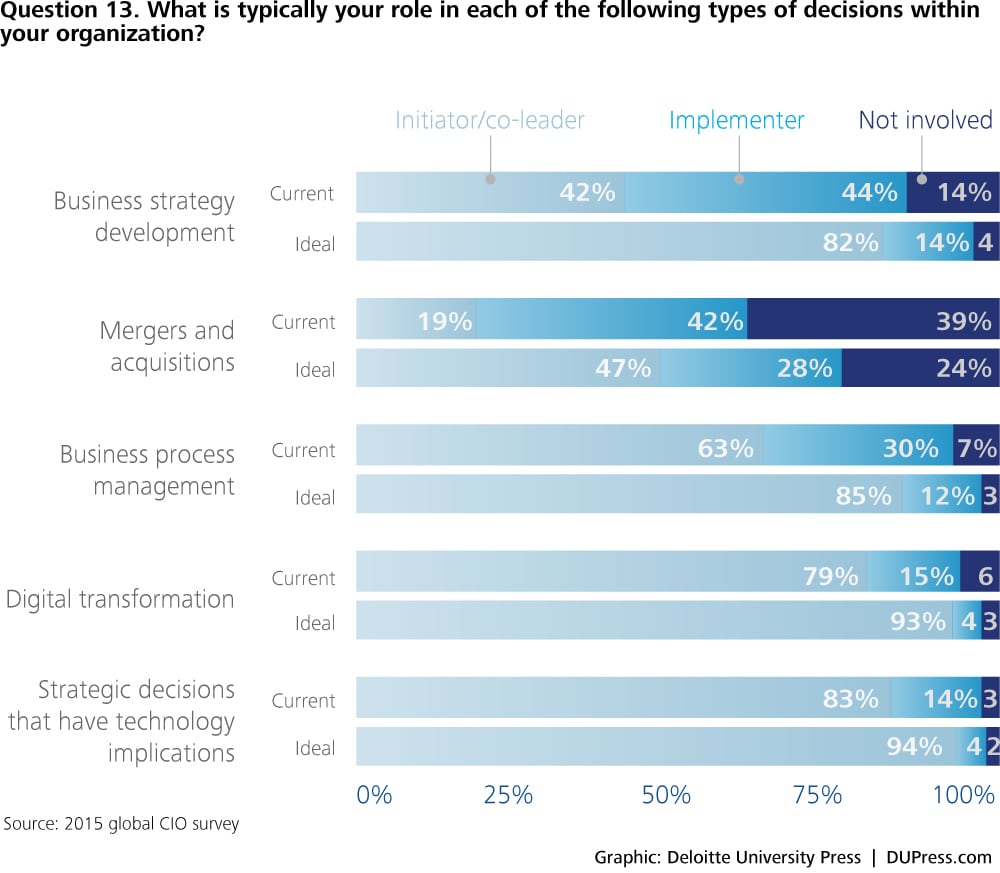





About this research
CIOs lead unique and complex lives—operating at the intersection of business and IT to deliver value to their organizations. To help CIOs manage these challenges and issues, Deloitte has created the CIO Program. The program provides distinctive offerings to support the CIO career lifecycle through leadership development programs, immersive lab experiences, insight on provocative topics, and career transition support to complement the technology services and solutions we provide to our clients.
This research was conducted during April–July 2015 across 43 countries with an aim to better understand the impact and the legacy of the CIO role. The research was conducted through in-depth interviews and online surveys. Globally, 1,271 technology leaders participated in this research across 21 industry segments. We used clustering analysis to segment the respondent population into three patterns and used textual analysis of open-ended questions and interview responses to validate the results and further define the CIO patterns.
About Deloitte’s CIO program
Deloitte’s CIO Program helps leaders thrive at the intersection of business and IT by providing career support, connections, insights, and services designed for CIOs and their organizations. Email us at USCIOProgram@deloitte.com to learn more.
© 2021. See Terms of Use for more information.






